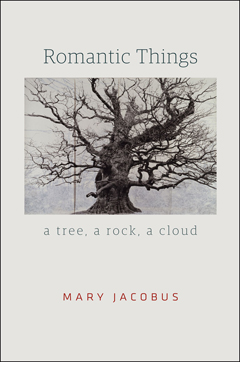 Book: Mary Jacobus, Romantic Things: A Tree, a Rock, a Cloud (University of Chicago Press Books)
Book: Mary Jacobus, Romantic Things: A Tree, a Rock, a Cloud (University of Chicago Press Books)
?Clouds puzzle us by representing, not so much the mind in a state of reflection, as the latency involved in all visible representation?not fullness versus flatness only (as Damisch argues), but absence?the ungraspable or unattainable; things we cannot see, as well as things visible to the eye.?
Maurice Merleau-Ponty, quoted by Mary Jacobus in Romantic Things
Those Who’ve Looked at Clouds from Both Sides Now
If you live with nature, just look out your window. If not, close your eyes. Now imagine your body prostrate on the earth, spreading out to encompass and absorb every natural object in sight, soaking up the dew and sunlight until you lose the awareness of your own ego and become one with the earth. After doing this you may have an inkling of the romantic mindset, as well as an idea of where Jacobus is coming from in this remarkable little book.
The romantic era, its full fruition roughly covering the first half of the 19th century, was in part a reaction to class inequality, aristocratic entitlement and decadence, industrialization, and a real or imagined exile from the pastoral life. The reaction took the form of a passionate embrace?and unusual confidence in?strong feelings, imagination, nature, people of the earth, mythology, folk culture, and the exterior and interior reflecting each other until the distinction between them blurs.
We have a lingering repugnance for all things romantic, brought on perhaps by the cleansing brush of existentialism that cleaned up a lot of the false sentimentality in romanticism and the Victorianism that followed it. It’s similar to the way that my generation turned up its nose at sentiment, idealism, and nature in reaction to the excesses and failures of ?60s-era romanticism.
The purpose of Romantic Things is to plumb the meaning of key images important to Romanticism in art, poetry, and ideas and to explore their meaning as carefully as a scuba diver explores a colossal shipwreck, turning each object over carefully, grouping like with like, then bringing them all up to the surface to show us how they’re relevant to the world above sea level.
The connections are relevant now, on several levels, even the meteorological. Jacobus points out that some of the gorgeous sunsets depicted in the paintings of this era came about because of certain volcanic eruptions that tinged the sky. She draws parallels with sky phenomena that today are the result of industrial pollution.
This isn’t the only suggestion that we may be due for a return to the romantic ways of thinking in the not-too-distant future. The conditions that produced the first sweeping romantic movement have returned, or have at least become more salient in our consciousness due to the fact that after all this time they just won’t fade away.
Because this was written by an academic for scholars of romanticism, the language is a bit fusty. However, with its brilliant points of light in the form of perfectly put phrases, Romantic Things makes salient its own implicit assertion that the boundary line between academic pursuits and art is as weighty yet as indefinable as a cumulus cloud.
Thanks to a detailed index, this book is a lot like Oskar Seyffert’s 19th-century Dictionary of Classical Antiquities?a great tome to occupy the poet’s desk and to be used as a reference when, for example, you become obsessed with water and want to know what Wordsworth had to say on the subject.
Jacobus details the current scientific discoveries that had a huge impact on how artists of the romantic era interpreted the images both aesthetically and emotionally, and really shows how important this period was in refining science as a holistic mode of thought. I’ve read a few 20th-century naturalist works that were so vivid, precise, and verbally expressive that they approached poetry, and now I can’t help thinking that these might never have been created or published were it not for the influence of the romantic thinkers.
The digital age, with its emphasis on technological innovation, has distracted us from all this. The current indices of a return to a preoccupation with things natural, emotional, and beautiful are underlined by the appearance of Romantic Things.
Romantic Things manifests eight of the Mindful Bard’s criteria for books well worth reading: 1) it is authentic, original, and delightful; 2) it poses and admirably responds to questions that have a direct bearing on my view of existence; 3) it stimulates my mind; 4) it is about attainment of the true self; 5) it inspires an awareness of the sanctity of creation; 6) it displays an engagement with and compassionate response to suffering; 7) it gives me artistic tools; and 8) it makes me want to be a better artist.
Wanda also penned the poems for the artist book They Tell My Tale to Children Now to Help Them to be Good, a collection of meditations on fairy tales, illustrated by artist Susan Malmstrom.

